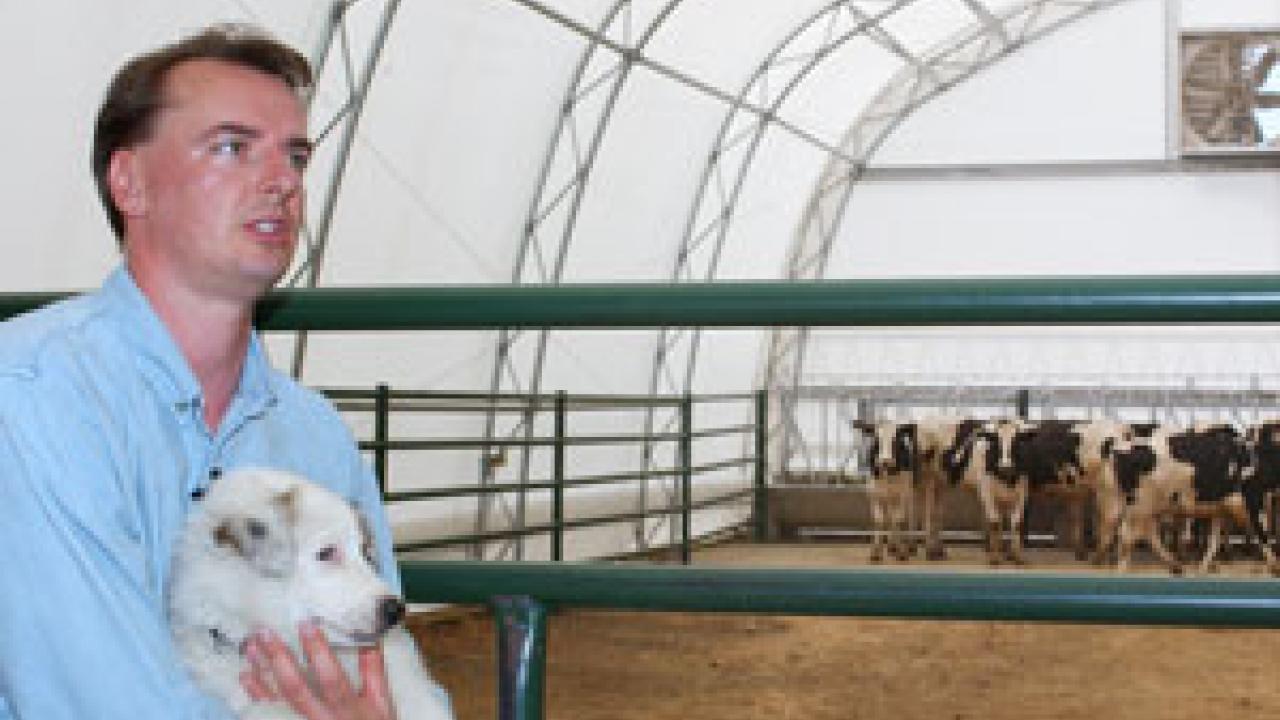On the trail of fugitive dust, a UC Davis air-quality specialist discovered that some very outdated science is causing fits in the state's dairy industry. Now he has launched a first-of-its-kind research project to get to the bottom of Bossie's contribution to air pollution.
For the next two years Frank Mitloehner, a UC Cooperative Extension specialist in the Department of Animal Science, will monitor several dozen Holstein heifers in airtight bovine bio-bubbles. Housing the cows in these greenhouse-like structures will enable scientists to quantify airborne emissions of ammonia, particulate matter or "fugitive dust," and volatile organic compounds that give rise to ozone.
"This is the only controlled project like this in the country," Mitloehner said. "We will be measuring nutrients fed to and excreted from cows and all the related emissions released into a closely monitored atmosphere."
What prompted this unusual research project is concern over air quality in the San Joaquin Valley, which ranks among the worst in the country. The valley also has a high concentration of dairy farms that add dust and air emissions to the atmosphere. Detailed data about the dairy industry's role in air quality are needed to give the industry and state agencies current information for regulatory decisions.
The $600,000 study is funded by the State Water Resources Control Board and Merced County and has received matching funds from UC Davis.
Looking much like Quonset huts, Mitloehner's four covered corrals each measure 70 by 40 feet and arch 15 feet high. Each pen will house 10 heifers (young cows that have never given birth) or 10 non-lactating adult cows, which typically make up more than half of a dairy's herd.
In addition to emissions, animal scientists will monitor ambient air and surface temperature, surface moisture, relative humidity, static pressure and the volume of air moving through the bio-bubbles.
In the first year of the project, Mitloehner's team of graduate students and staff researchers will be investigating several methods to reduce dust, ammonia and volatile organic compounds. Rice straw bedding, for instance, is believed to reduce ammonia emissions and could have other benefits, too -- keeping livestock pens dry in winter and dust-free in summer while creating a new use for an agricultural waste product.
Ammonia is of concern because it combines with nitrogen or sulfur oxides to create irritating, fine dust particles that pose health risks. Dust kicked up by the trampling of dried dairy or feedlot manure is another health concern because tiny particles known as PM 10 or PM 2.5 (a reference to particle size in microns) are a human respiratory hazard.
In the second year of the project, Mitloehner's team will examine how various feed rations affect what wafts into the atmosphere.
A concurrent study will house a smaller number of cows in smaller, more tightly controlled environmental chambers to evaluate emissions and provide state regulators with an emission factor grounded in good, current science.
The San Joaquin Valley Air Pollution Control District recently issued new rules that require dairies with more than 500 cows, and farmers with more than 100 contiguous acres of cropland, to implement conservation management practices to control dust by December 31. As of July 1, new state legislation requires air permits for all agricultural operations whose emissions exceed a certain threshold.
"The emission factor that determines dairy emissions today is derived from a study that is not only critically outdated but that did not measure volatile organic compounds at all," Mitloehner said. "Nonetheless, this is how air-quality regulators are determining who requires a permit until better data are available."
Mitloehner knows dairy air. He studied how to reduce stockyard emissions in Texas before becoming a UC Davis Extension specialist in 2002. This spring he worked with more than 700 dairy producers in air-quality workshops throughout the San Joaquin Valley, educating them on air quality issues, helping them conduct on-farm assessments and walking them through the permitting process.
Media Resources
John Stumbos, (530) 754-2261, jdstumbos@ucdavis.edu
